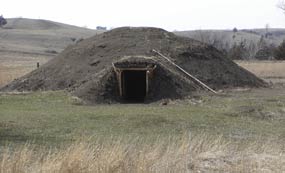 |
| NPS photo | | An earth lodge built by the Ponca Tribe of Nebraska in 2003 near Niobrara, Nebraska. This project was funded by the CCSP. |
 |
The joint efforts of many individuals and groups – among them military men and scientists, a president andan enslaved man, French-speaking boatmen and American Indians, women and men – determined the fate of the Corps of Discovery. Today, more than 100 groups partner with the National Park Service to share the stories of the Expedition and to preserve the resources of the Lewis and Clark National Historic Trail. Partners include a diverse group of federal agencies, tribal nations, state and local entities, and even private land owners. This page has been developed to provide information and assistance to all of those partners.
Lewis and Clark did not travel to the Pacific Ocean and back alone. Their journey required the work of many: military men of the expedition, hired interpreters, Sacagawea, American Indian tribes, French boatmen and many more. Today, the work of Lewis and Clark National Historic Trail is performed by far more than a few National Park Service staff. The Challenge Cost Share Program (CCSP) is one way the National Park Service (NPS) and its many partners accomplish the work of conserving the natural and cultural resources of the Trail for future generations.
Since 1995, Congress has legislated funds to the NPS under the CCSP. These funds are intended to increase participation by qualified partners in the preservation and improvement of National Park Service natural, cultural, and recreational resources; in all authorized Service programs and activities; and on national trails. The NPS and partners work together on projects with mutually beneficial, shared outcomes. The matching fund program requires a minimum 100% cost share from non-federal sources. Thanks to the investment of CCSP funds, the NPS and many state, local, tribal and not-for-profit agencies have built hundreds of miles of trails, educated thousands of children about their natural and cultural heritage, and restored acres of historic landscapes.
Second Round of FY2009 CCSP Annnounced - Learn more about the CCSP application process here.
For CCSP information, please phone:
Dan Wiley, Chief of Resources Stewardship, 402-661-1830
Carol McBryant, Chief of Interpretation, 402-661-1818
Dick Basch, American Indian Liaison, 503-861-4404
Lee Smith, Administrative Officer, 402-661-1808
|






